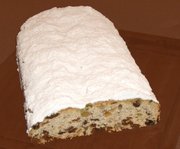
Stollen is a bread-like cake traditionally made in Germany, usually eaten during the Christmas season as Weihnachtsstollen or Christstollen. Stollen (originally Striezel) was created in Dresden in around 1450, and the most famous Stollen is still the Dresdner Stollen, sold, among other places, at the local Striezelmarkt Christmas market.
Stollen is a light airy fruitcake made with yeast, water and flour, and usually dried citrus peel (called "Zitronad(e)), dried fruit, almonds, and spices such as cardamom and cinnamon; the dough is quite low in sugar. The finished cake is sprinkled with icing sugar. The traditional weight is 2 kg, but smaller sizes are now available.
Contents |
History
The old name Striezel was from strüzel or stroczel, "awaken" (Old Prussian: troskeilis), which came to mean "loaf of bread". The shape of the cake was originally meant to represent the baby Jesus wrapped in swaddling clothes, and was one of a number of baked goods created to represent aspects of the Crucifixion: the pretzel represented Jesus' bonds, and the (holeless) doughnut (Pfannkuchen) represented the sponge given to Jesus on the cross. However, the Stollen reminded Erzgebirge miners of the entrance to a mine tunnel, which is the literal meaning of Stollen, and they renamed it.
When Stollen was first baked, the ingredients were very different. The Advent season was a time of fasting, and bakers were not allowed to use butter, only oil, so the cake was tasteless and hard. In 1647, Prince Elector Ernst and his brother Duke Albrecht decided to remedy this by writing to the then Pope, Pope Innocent X. They explained that Saxon bakers needed to use butter as oil was so expensive and hard to come by, and had to be made from turnips, which was unhealthy. The Pope granted the use of butter without having to pay a fine - but only for the Prince-Elector and his family and household. In 1691 others were also permitted to use butter, but with the condition of having to pay annually 1/20th of a gold Gulden to support the building of the Freiberg Cathedral. The ban on butter was removed when Saxony became Protestant.
Over the centuries the cake changed from being a simple, fairly tasteless "bread" to a sweeter cake with richer ingredients such as marzipan, although the traditional Stollen is today still not as sweet as the copies made around the world.
Stollen today
Today the cake is available in many parts of the world. The true Dresden Stollen, however, is produced in the city and distinguished by a special seal depicting the city's famous king, August the Strong. This "official" Stollen is produced by only 150 bakers.
Every year in Dresden a Stollenfest takes place. This recent tradition has taken place only since 1994, but the idea comes from the days of August the Strong in the 18th century: the king loved pomp and feasts, and in 1730 impressed his subjects with a giant 1.7-tonne Stollen big enough for everyone to have a portion. Today the festival takes place on the Saturday before the second Advent Sunday, and the cake weighs between three and four tonnes. A carriage takes it in a parade through the streets of Dresden to the Christmas market, where it is ceremoniously cut into pieces and distributed among the crowd, for a small sum which goes to charity. The largest Stollen was baked in 2000: it weighed 4.2 tonnes and is in the Guinness Book of World Records.
See also
External links
- Dresden Stollen Festival
- Dresden Stollen history, in English from a Germany embassy
- Photos of Stollen being baked, in German
- Stollen history, in German
Recipes
- Stollen Recipe for Christmas
- A German Stollen recipe, in German and English
- German Stollen recipe, in German
- Preparation Tips
Categories: Christmas food
